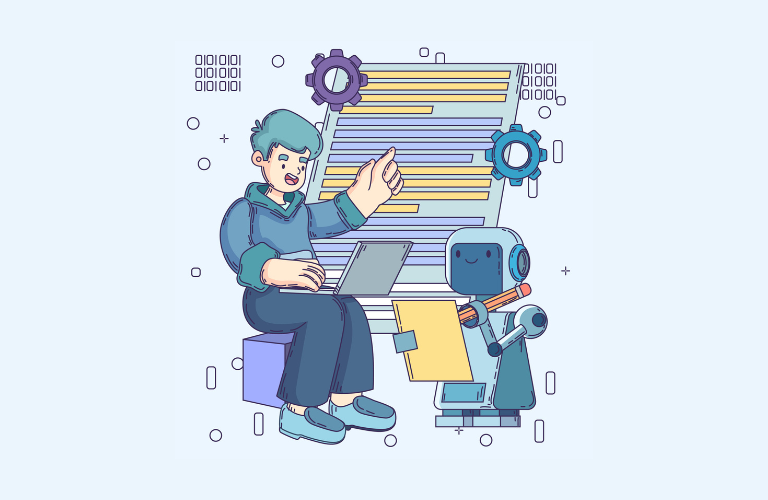Free AI LLMs are transforming how developers build applications, automate tasks, and solve complex problems in 2025. These open-source large language models provide powerful, cost-effective solutions for coding, text generation, and more, without the hefty price tag of proprietary systems.
Whether you’re a solo developer or part of a large team, leveraging free AI LLMs can save time, enhance performance, and unlock customization. This article explores the top 10 free AI LLMs, focusing on efficiency, usability, and practical implementation to address pain points like slow performance or limited resources.
Table of Contents
Why Choose Free AI LLMs?
Free AI LLMs offer developers unmatched flexibility and control. Unlike closed-source models, these tools allow you to modify code, fine-tune for specific tasks, and deploy on your infrastructure. This transparency eliminates vendor lock-in and reduces costs, making them ideal for startups and individual developers.
- Cost Savings: No licensing fees or per-token charges.
- Customization: Tailor models to your project’s needs.
- Community Support: Access a global network of developers for updates and fixes.
- Data Privacy: Host models locally to secure sensitive information.
Top 10 Free AI LLMs for 2025
Here’s a curated list of the top 10 free AI LLMs, sorted by efficiency and usability, with practical use cases and implementation tips to streamline your workflow.
1. LLaMA 3
Developed by Meta AI, LLaMA 3 is a powerhouse free AI LLM for dialogue and code generation. Available in 8B and 70B parameter sizes, it’s optimized for high-speed inference.
- Use Case: Build chatbots or automate code reviews.
- Implementation: Use Hugging Face Transformers for easy integration.
pip install transformers
from transformers import AutoModelForCausalLM, AutoTokenizer
model = AutoModelForCausalLM.from_pretrained("meta-llama/Llama-3-8B")
tokenizer = AutoTokenizer.from_pretrained("meta-llama/Llama-3-8B")Shortcut: Pre-trained weights on GitHub save setup time.
2. Google Gemma 2
Google’s Gemma 2, available in 9B and 27B sizes, is a lightweight free AI LLM designed for fast inference on various hardware, from laptops to cloud GPUs.
- Use Case: Generate technical documentation or code snippets.
- Implementation: Run with Ollama for local deployment.
ollama run google/gemma-2-9bShortcut: Use quantized versions to reduce memory usage by 30%.
3. Mistral-8x22B
Mistral AI’s Mixtral-8x22B is a sparse Mixture-of-Experts model with 39B active parameters, excelling in multilingual NLP and coding tasks.
- Use Case: Develop multilingual chat applications.
- Implementation: Deploy via Hugging Face.
from transformers import pipeline
nlp = pipeline("text-generation", model="mistralai/Mixtral-8x22B-Instruct-v0.1")Shortcut: Enable constrained output mode for faster responses.
4. Falcon 2
Falcon 2, from the Technology Innovation Institute, offers 11B parameters and vision-to-language capabilities, making it a versatile free AI LLM.
- Use Case: Convert images to text for eCommerce platforms.
- Implementation: Run on a single GPU with minimal setup.
ollama run falcon2:11bShortcut: Use pre-built Docker images to deploy in minutes.
5. Qwen1.5
Alibaba’s Qwen1.5 spans 0.5B to 110B parameters, with quantized versions for edge devices, making it a highly efficient free AI LLM.
- Use Case: Fine-tune for industry-specific chatbots.
Implementation: Integrate with vLLM for high-throughput inference.
pip install vllm
from vllm import LLM
llm = LLM(model="Qwen/Qwen1.5-7B")Shortcut: Use GGUF formats for 50% faster loading.
6. BLOOM
BLOOM, a 176B-parameter free AI LLM by BigScience, supports 46 languages, ideal for research and multilingual applications.
- Use Case: Translate user manuals across languages.
- Implementation: Access via Hugging Face’s inference API.
curl https://api-inference.huggingface.co/models/bigscience/bloomShortcut: Use the inference API to bypass local setup.
7. GPT-NeoX
EleutherAI’s GPT-NeoX, with 20B parameters, is a free AI LLM trained on the Pile dataset, excelling in language understanding and few-shot tasks.
- Use Case: Automate content summarization.
Implementation: Run with DeepSpeed for distributed training.
pip install deepspeed
python -m deepspeed.launcher.runner --num_gpus 4 run_gpt_neox.pyShortcut: Pre-trained checkpoints reduce fine-tuning time.
8. Vicuna-13B
Vicuna-13B, fine-tuned on LLaMA, is a free AI LLM delivering 90% of ChatGPT’s quality for conversational tasks at minimal cost.
- Use Case: Create customer support bots.
Implementation: Deploy with FastChat for scalability.
pip install fschat
python -m fastchat.serve.cli --model vicuna-13bShortcut: Use SkyPilot to cut serving costs by 20%.
9. CodeLlama
Meta’s CodeLlama, built on LLaMA 2, is a free AI LLM tailored for coding, available in 7B, 13B, 34B, and 70B sizes.
- Use Case: Generate Python scripts or debug code.
- Implementation: Run with Ollama for local inference.
ollama run codellama:13bShortcut: Enable FIM mode for instant code completion.
10. StarCoder2
StarCoder2, from BigCode, is a free AI LLM with 3B to 15B parameters, trained on 3.3T tokens for superior code generation.
- Use Case: Automate unit test creation.
Implementation: Use Hugging Face Transformers.
from transformers import AutoModelForCausalLM
model = AutoModelForCausalLM.from_pretrained("bigcode/starcoder2-15b")Shortcut: Run on 4xL4 GPUs to save 40% on costs.
Solving Common Pain Points with Free AI LLMs
Developers often face challenges like slow model performance, high resource demands, or complex setups. Here’s how free AI LLMs address these issues:
- Slow Performance: Models like Gemma 2 and Qwen1.5 use quantization to reduce latency by up to 50%.
- High Costs: Hosting StarCoder2 on affordable GPUs like E2E’s 4xL4 cuts expenses significantly.
- Complex Deployment: Tools like Ollama and vLLM simplify setup with one-line commands.
- Limited Customization: Open-source models allow fine-tuning with domain-specific data, unlike proprietary systems.
Tips for Maximizing Free AI LLM Efficiency
To get the most out of these free AI LLMs, follow these actionable tips:
- Optimize Hardware: Match models to your GPU—use V100 for Mistral-8x22B or H100 for CodeLlama-70B.
- Quantize Models: Reduce memory usage with Int4 or Int8 formats for edge deployments.
- Leverage Frameworks: Use Hugging Face or vLLM for faster inference and fine-tuning.
- Monitor Performance: Tools like NetApp Instaclustr provide real-time insights to avoid downtime.
Use Case Example: Building a Code Assistant
Imagine you’re building a code assistant for your team. StarCoder2’s 15B model is a great choice due to its efficiency and low GPU requirements (9.51GB). Here’s a quick setup:
1. Install Dependencies:
pip install transformers torch2. Load Model:
om transformers import pipeline
coder = pipeline("text-generation", model="bigcode/starcoder2-15b")3. Generate Code:
pompt = "Write a Python function to sort a list"
output = coder(prompt, max_length=100)
print(output[0]["generated_text"])This setup takes under 10 minutes and delivers reliable code suggestions, saving hours of manual coding.
Why Free AI LLMs Are the Future
Free AI LLMs empower developers to innovate without financial or technical barriers. Their open-source nature fosters collaboration, ensuring continuous improvements. In 2025, models like LLaMA 3 and CodeLlama are leveling the playing field, making advanced AI accessible to all.
- Scalability: Deploy on cloud or edge with minimal tweaks.
- Community-Driven: Benefit from global contributions and updates.
- No Vendor Lock-In: Retain full control over your AI stack.
Conclusion
Free AI LLMs are game-changers for developers in 2025, offering high efficiency, customization, and cost savings. From LLaMA 3’s dialogue prowess to StarCoder2’s coding finesse, these models solve real-world problems like slow performance and high costs.
By implementing them with tools like Ollama or vLLM, you can streamline workflows and boost productivity. Start experimenting with these free AI LLMs today to unlock their full potential for your projects.
FAQs
1. What are free AI LLMs, and how do they work?
Free AI LLMs are open-source large language models that developers can use, modify, and deploy without cost. They work by processing text inputs, understanding context, and generating human-like responses or code, powered by neural networks trained on vast datasets.
2. Why should I use a free AI LLM instead of a paid one?
Free AI LLMs offer cost savings, full customization, and no vendor lock-in. You can host them locally for better data privacy and fine-tune them for specific tasks, unlike paid models that often limit control and charge per use.
3. Which free AI LLM is best for coding in 2025?
CodeLlama and StarCoder2 are top choices for coding. CodeLlama excels in generating and debugging code across languages, while StarCoder2 is lightweight and efficient, ideal for automating tasks like unit test creation.
4. How can I run a free AI LLM on my laptop?
You can run models like Gemma 2 or Qwen1.5 using tools like Ollama. Install Ollama, then use a command like ollama run google/gemma-2-9b. Ensure your laptop has at least 16GB RAM and a compatible GPU for smooth performance.
5. Are free AI LLMs secure for sensitive data?
Yes, free AI LLMs are secure when hosted locally. By deploying models like LLaMA 3 or Falcon 2 on your infrastructure, you control data access, avoiding third-party risks common with cloud-based paid models.
6. Can I fine-tune a free AI LLM for my project?
Absolutely! Models like Mistral-8x22B and Vicuna-13B support fine-tuning. Use frameworks like Hugging Face Transformers or vLLM with domain-specific data to customize the model for tasks like chatbots or content generation.
7. How do free AI LLMs save time for developers?
Free AI LLMs automate repetitive tasks like code writing, debugging, or documentation. Tools like Ollama and pre-trained weights (e.g., for GPT-NeoX) simplify setup, while shortcuts like quantization reduce inference time by up to 50%.




